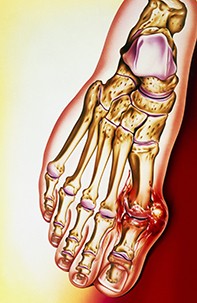Peer Reviewed
Feature Article Rheumatology
Treating to target in gout: simple steps towards effective long-term control
Abstract
In almost all cases of the common condition gout, treatment options are available to fully control the disease, and yet treatment outcomes are often poor. The following of relatively simple guidelines, especially to achieve and maintain urate levels below target levels, gives the best chance of effective long-term control.
Key Points
- An acutely inflamed joint usually warrants aspiration. Examination of the synovial fluid is the best way to differentiate bacterial infection from crystal-induced arthritis (such as gout) and other less common disorders.
- The treatment of acute gout is determined by the patient’s comorbidities. NSAIDs, corticosteroids (oral, intramuscular or intra-articular), intramuscular depot tetracosactrin (off-label use) and colchicine are all reasonable options.
- Confirmation of the diagnosis of gout, by identifying urate crystals using polarised light microscopy is of great value prior to commencing long-term (usually lifelong) urate-lowering drug therapy (ULT).
- When ULT is used, achieving the target serum urate level is of vital importance. The targets are: for nontophaceous gout, <0.36 mmol/L; for tophaceous gout, <0.30 mmol/L.
- Whichever ULT is chosen, in the early phase there is an increased risk of flares, and the risk is higher if the serum urate falls more rapidly. It is wise to introduce ULT at a low dose and to use prophylactic drug therapy (usually colchicine) to avoid flares.
- Allopurinol 300 mg daily is often too low a dose to achieve the target serum urate level. It is safe and effective to progressively increase the dose of allopurinol to 600 mg daily or, if needed, 900 mg daily.
Picture credit: © John Bavosi/SPL
Purchase the PDF version of this article
Already a subscriber? Login here.

